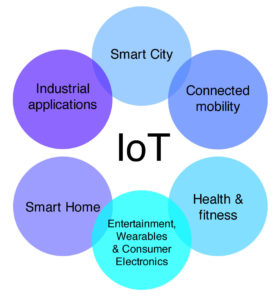
The IOT – the Internet of Things is a term which is only a few years old. You may be asking yourself, what exactly is IoT? A good high-level explanation of the primary different groups of IoT and IoT devices is shown in the image on the left. You may experience IoT devices every day without even knowing they are there.
It may be the health tracking device you wear. Or it might be an APP on your smartphone that tracks your steps, food intake, and water consumption. Other home-based applications such as smart thermostats, Amazon Echo, or Google Assistant are on the edge of this technology.
IoT – Internet of Things definition:
- “Sensors and actuators embedded in physical objects that are linked through wired and wireless networks”
- The term Internet of Things is 16 years old
- The term Internet of Things was invented initially to promote RFID technology
- The actual idea of connected devices goes back to around the ’70s when it was referred to as “embedded internet”
- The actual term was coined by Kevin Ashton in 1999 during his work at Procter&Gamble.
- The popularity of the term IoT did not accelerate until 2010/2011 and when it reached the mass market in early 2014
Today there is a plethora of these devices on the market. The one I have is a Helium Hotspot. With a Helium Hotspot, anyone can earn cryptocurrency by building a wireless network in their city and creating a more connected future. With our Helium devices, we are building Peoples’ Network.
Learning about the benefits of the IoT opens the door for more information. We have all seen shows depicting the future showing mini-computers running all the things in the home. Maybe it is the IoT.
So What are the IOT Things?
Perhaps your smartwatch connecting with your smartphone. Your Smart Phone connecting to your security system, thermostat, garage door opener, even the sprinkler system!
Think of IoT as a means in which anything connected to the internet communicates with other things connected to the internet. However, it does not replace WiFi for connecting us humans to the internet. Every day there are more and more devices that have sensors in them to communicate with other things.
What is the benefit?
Homes benefit with better temperature control. Our pets will benefit with their smart collars by being found more quickly when they are lost. That Saturday morning lawn watering may be more efficiently under control. And you can monitor it all from your smart-phone while working on other chores.
Actually this isn’t too far off from what we can do today. We have Smartphones, Smartwatches, tablets, computers and even more that can communicate with each other to make simple actions by us even easier. There are now cameras we can control from our phones, doorbells that are cameras and vacuums that operate with a touch of a remote button. Our phones and watches communicate with each other to track our sleep and activity patterns. More impressively, they can tell us when something is not normal. Recent sporting events where fans have gotten overly exuberant receive alerts telling them of abnormal heart rates, sometimes preventing cardiac arrest.
Internet of Things Benefits Going Global
Our world is experiencing the benefits of this network expansion because we are developing “smart cities”. Smart Cities promote efficiency in energy as well as encourage the reduction of waste. How can you help? By investing and believing in the future now. You may not think by getting rid of that trusty flip-phone will gain you any benefits, but you may just be surprised. But you want to upgrade your “things” that are smart-connected so they can communicate other smart things.
In Conclusion
You too can become a part of this People’s Network. You too can own your own IoT and be a part of building the network in your city. Go here to see how.



